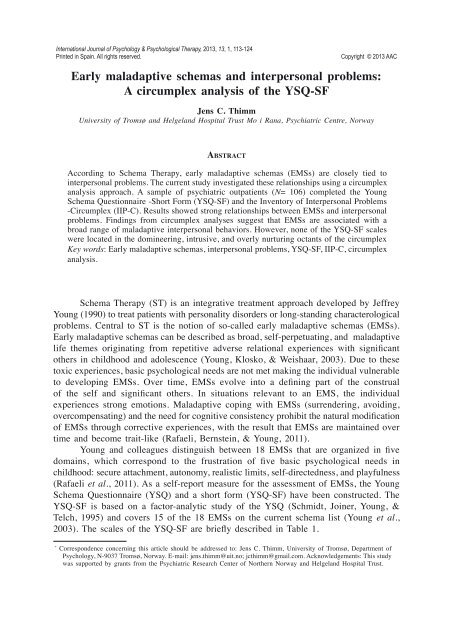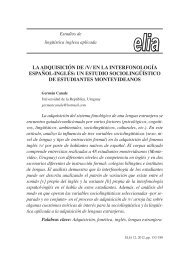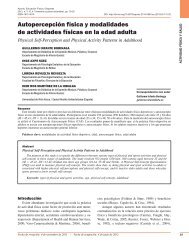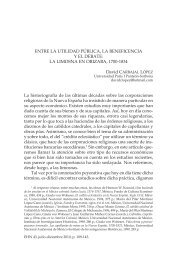wkfHD6mD
wkfHD6mD
wkfHD6mD
Create successful ePaper yourself
Turn your PDF publications into a flip-book with our unique Google optimized e-Paper software.
International Journal of Psychology & Psychological Therapy, 2013, 13, 1, 113-124<br />
Printed in Spain. All rights reserved. Copyright © 2013 AAC<br />
Early maladaptive schemas and interpersonal problems:<br />
A circumplex analysis of the YSQ-SF<br />
Jens C. Thimm<br />
University of Tromsø and Helgeland Hospital Trust Mo i Rana, Psychiatric Centre, Norway<br />
AbstrAct<br />
According to Schema Therapy, early maladaptive schemas (EMSs) are closely tied to<br />
interpersonal problems. The current study investigated these relationships using a circumplex<br />
analysis approach. A sample of psychiatric outpatients (N= 106) completed the Young<br />
Schema Questionnaire -Short Form (YSQ-SF) and the Inventory of Interpersonal Problems<br />
-Circumplex (IIP-C). Results showed strong relationships between EMSs and interpersonal<br />
problems. Findings from circumplex analyses suggest that EMSs are associated with a<br />
broad range of maladaptive interpersonal behaviors. However, none of the YSQ-SF scales<br />
were located in the domineering, intrusive, and overly nurturing octants of the circumplex<br />
Key words: Early maladaptive schemas, interpersonal problems, YSQ-SF, IIP-C, circumplex<br />
analysis.<br />
Schema Therapy (ST) is an integrative treatment approach developed by Jeffrey<br />
Young (1990) to treat patients with personality disorders or long-standing characterological<br />
problems. Central to ST is the notion of so-called early maladaptive schemas (EMSs).<br />
Early maladaptive schemas can be described as broad, self-perpetuating, and maladaptive<br />
life themes originating from repetitive adverse relational experiences with significant<br />
others in childhood and adolescence (Young, Klosko, & Weishaar, 2003). Due to these<br />
toxic experiences, basic psychological needs are not met making the individual vulnerable<br />
to developing EMSs. Over time, EMSs evolve into a defining part of the construal<br />
of the self and significant others. In situations relevant to an EMS, the individual<br />
experiences strong emotions. Maladaptive coping with EMSs (surrendering, avoiding,<br />
overcompensating) and the need for cognitive consistency prohibit the natural modification<br />
of EMSs through corrective experiences, with the result that EMSs are maintained over<br />
time and become trait-like (Rafaeli, Bernstein, & Young, 2011).<br />
Young and colleagues distinguish between 18 EMSs that are organized in five<br />
domains, which correspond to the frustration of five basic psychological needs in<br />
childhood: secure attachment, autonomy, realistic limits, self-directedness, and playfulness<br />
(Rafaeli et al., 2011). As a self-report measure for the assessment of EMSs, the Young<br />
Schema Questionnaire (YSQ) and a short form (YSQ-SF) have been constructed. The<br />
YSQ-SF is based on a factor-analytic study of the YSQ (Schmidt, Joiner, Young, &<br />
Telch, 1995) and covers 15 of the 18 EMSs on the current schema list (Young et al.,<br />
2003). The scales of the YSQ-SF are briefly described in Table 1.<br />
* Correspondence concerning this article should be addressed to: Jens C. Thimm, University of Tromsø, Department of<br />
Psychology, N-9037 Tromsø, Norway. E-mail: jens.thimm@uit.no; jcthimm@gmail.com. Acknowledgements: This study<br />
was supported by grants from the Psychiatric Research Center of Northern Norway and Helgeland Hospital Trust.
114<br />
Thimm<br />
Scale<br />
Disconnection and rejection domain<br />
Table 1. YSQ-SF scales.<br />
Description<br />
Emotional deprivation<br />
The expectation that one’s need for nurturance, empathy, and protection will not be met<br />
by others.<br />
Abandonment<br />
The belief that significant others providing support are unstable, unreliable or<br />
unpredictable.<br />
Mistrust The expectation that others will intentionally hurt, abuse, cheat, or take advantage.<br />
Social isolation<br />
The feeling that one is fundamentally different from other people, isolated, and not part<br />
of a community.<br />
Defectiveness The belief that one is inherently flawed, defective, and unlovable.<br />
Impaired autonomy and performance domain<br />
Failure<br />
The belief that one is fundamentally inadequate when it comes to performance and<br />
achievement.<br />
Dependence The belief that one is dependent of others to handle everyday life.<br />
Vulnerability The fear that an imminent and unpreventable catastrophe will strike at any time.<br />
Enmeshment<br />
Other-directedness domain<br />
Extensive emotional involvement and closeness with significant others at the expense of<br />
full individuation.<br />
Subjugation<br />
The belief that one has to surrender control to others and to suppress one’s own needs<br />
and emotions.<br />
Self-sacrifice<br />
An excessive focus on meeting the needs of others at the expense of one’s own needs and<br />
well-being.<br />
Overvigilance and inhibition domain<br />
Emotional inhibition The belief that one must inhibit spontaneous feelings and actions.<br />
Unrelenting standards<br />
Impaired limits domain<br />
The belief that one must strive to meet high internalized standards.<br />
Entitlement The belief that one is superior and entitled to special rights and privileges.<br />
Insufficient self-control A lack of self-control and tolerance of frustration to achieve one’s goals.<br />
In ST, EMSs and maladaptive coping responses are proposed to underlie personality<br />
disorders and some recurrent or chronic axis-I disorders (e.g., depression, anxiety, or<br />
substance abuse) as well as milder psychological problems, such as relationship difficulties<br />
or problems at work (Young, 1990). An accumulating body of research has confirmed<br />
that EMSs are related to a broad range of psychiatric diagnoses and psychological<br />
problems, particularly personality disorders (e.g., Brotchie, Meyer, Copello, Kidney,<br />
& Waller, 2004; Dutra, Callahan, Forman, Mendelsohn, & Herman, 2008; Hawke &<br />
Provencher, 2011; Lee, Taylor, & Dunn, 1999; Waller, Kennerly, & Ohanian, 2007).<br />
Interpersonal problems are present in axis-I and axis-II disorders (e.g., Cain<br />
et al., 2012; Hilsenroth, Menaker, Peters, & Pincus, 2007; Salzer et al., 2008; Soldz,<br />
Budman, Demby, & Merry, 1993) and are often the reason why clients seek psychological<br />
treatment (Horowitz, 1979). From an ST perspective, these problems can often be<br />
understood as maladaptive coping responses to EMSs. In contrast to early definitions<br />
of EMSs (e.g., McGinn, Young, & Sanderson, 1995), the current conceptualization of<br />
EMSs emphasizes that maladaptive behaviors are not considered part of schemas, but are<br />
driven by schemas (Young et al., 2003). Hence, interpersonal problems may represent<br />
maladaptive interpersonal strategies that are used to manage the painful emotions that<br />
accompany the activation of EMSs.<br />
Thus, according to the ST model, EMSs reflect early adverse interaction patterns<br />
and lead to interpersonal difficulties later in life. Bernstein (2005) argues that EMSs<br />
are fundamentally interpersonal in nature. However, despite theoretically proposed close<br />
© InternatIonal Journal of Psychology & PsychologIcal theraPy, 2013, 13, 1 http://www. ijpsy. com
Early maladapTaTivE SchEmaS and inTErpErSonal problEmS 115<br />
connections between EMSs and interpersonal problems, to the author’s best knowledge,<br />
these relationships have not yet been empirically explored. Therefore, the aim of the<br />
present study is to fill this gap and to investigate how EMSs and interpersonal problems<br />
are related.<br />
It has been proposed that interpersonal behavior and interpersonal problems can<br />
be conceptualized and organized by means of a circumplex model (Alden, Wiggins, &<br />
Pincus, 1990; Leary, 1957; Wiggins, 1996). The interpersonal circumplex is defined by<br />
a circular arrangement of interpersonal behaviors around the two orthogonal dimensions<br />
of dominance (or control) and love (or affiliation) (Gurtman & Balakrishnan, 1998).<br />
These two dimensions are also referred to as agency and communion (Gurtman, 2009;<br />
Horowitz, Dryer, & Krasnoperova, 1997). It has been shown that these two dimension,<br />
rotated 45 degrees, correspond to the dimensions of agreeableness and extraversion of the<br />
five-factor model of personality (McCrae & Costa, 1989; Soldz et al., 1993). The circular<br />
space is often divided into eight segments or octants (Leary, 1957; Wiggins, 1979). The<br />
structural properties of the model make it possible to reduce a circular interpersonal<br />
profile to a vector in the interpersonal space and thereby to locate individuals within the<br />
circumplex and to classify them with respect to their predominant interpersonal style.<br />
In a similar way, psychological scales can be projected onto the circle to evaluate their<br />
relationships with interpersonal themes or their “interpersonalness” (Gurtman, 1991,<br />
1992). The structural properties of a circular profile of an individual or a scale can<br />
be summarized by three parameters: angular displacement, amplitude, and elevation<br />
(Gurtman & Balakrishnan, 1998; Wright, Pincus, Conroy, & Hilsenroth, 2009). The<br />
vector’s angle shows the predominant theme or central tendency in the profile. Its<br />
length or amplitude indicates whether there is a clear peak. The profile elevation shows<br />
the average interpersonal distress which has been related to maladjustment (Pincus &<br />
Gurtman, 2006).<br />
Thus, the aim of the current study is to examine the relationships between EMSs,<br />
as measured by the YSQ-SF, and interpersonal problems by conducting a circumplex<br />
analysis of the YSQ-SF scales. Based on the definitions of schema domains and the<br />
specific EMSs, it is hypothesized that the EMSs of the disconnection/rejection and<br />
overvigilance/inhibition domains are related to low dominance and low love. The impaired<br />
autonomy domain is expected to be associated with low dominance. The EMSs of the<br />
impaired limits domain is hypothesized to be related to high dominance and low love,<br />
whereas the opposite is expected for the EMSs of the other-directedness domain, namely<br />
low dominance and high love.<br />
Participants<br />
Method<br />
The present study included 106 psychiatric outpatients who participated in a study<br />
on the concept of EMSs (e.g., Thimm, 2010). Seventy-eight (74%) of the patients were<br />
female, and the patients’ average age was 40.3 years (SD= 12.2; range= 18-67). Of the<br />
http://www. ijpsy. com © InternatIonal Journal of Psychology & PsychologIcal theraPy, 2013, 13, 1
116<br />
Thimm<br />
participants in this study, 35% were married, 27% were single, 26% were cohabiting, 11%<br />
were divorced/separated, and 2% were widowed. The participants’ highest educational<br />
levels were as follows: lower secondary school 15%, upper secondary school 38%, and<br />
higher education 36% (11% did not report their education). All patients were diagnosed<br />
by their respective therapists using ICD-10 criteria. As an aid in the diagnostic process,<br />
the MINI (Sheehan et al., 1998) was employed. The majority of the patients had a<br />
diagnosis of depression/dysthymia (52%) or an anxiety disorder (22% social phobia,<br />
17% agoraphobia, 13% panic disorder, 6% generalized anxiety disorder). Other relatively<br />
frequent diagnoses in the sample were posttraumatic stress disorder (9%) and ADHD<br />
(5%). Forty-two (40%) patients had two or more diagnoses. A personality disorder<br />
was diagnosed in 12% of the participants. A detailed description of the distribution of<br />
diagnoses in the original sample can be found in Thimm (2011).<br />
Research procedure has been approved by the Regional Committee for Medical<br />
Research Ethics for Northern Norway.<br />
Instruments and measures<br />
Young Schema Questionnaire -Short Form (YSQ-SF). The YSQ-SF consists of 75 items<br />
measuring 15 EMSs (Table 1). Items are answered on a six-point Likert scale from<br />
“completely untrue of me” to “describes me perfectly”. Research has demonstrated that<br />
the scales of the Norwegian version of the YSQ-SF have adequate internal consistency<br />
and that its factor structure closely resembles the theoretically proposed structure on<br />
the first- and second-order levels (Hoffart et al., 2005).<br />
Inventory of Interpersonal Problems -Circumplex (IIP-C). The IIP-C (Alden et al., 1990)<br />
is a short circumplex version of the Inventory of Interpersonal Problems (Horowitz,<br />
Rosenberg, Baer, Ureño, & Villaseñor, 1988) with eight scales: domineering, intrusive,<br />
overly nurturing, exploitable, non-assertive, socially avoidant, cold, and vindictive. Its<br />
circumplex structure has been confirmed in several studies (Pincus & Gurtman, 2006).<br />
The IIP-C is composed of 64 statements describing general interpersonal problems.<br />
Items are rated on a 5-point Likert scale from “not at all” to “very much”, with 39<br />
of the statements referring to behavioral inhibitions and beginning with “it is hard<br />
for me to…” The remaining 25 items assess excesses in interpersonal behaviors and<br />
begin with “things that I do too much…” The Norwegian translation of the IIP-C has<br />
shown satisfactory psychometric properties and circumplex structure (Monsen, Hagtvet,<br />
Havik, & Eilertsen, 2006).<br />
Data analysis<br />
First, descriptive statistics (skewness, means, standard deviations, and Cronbach’s<br />
α) were calculated for all YSQ-SF and IIP-C scales. Prior to further analyses, highly<br />
skewed variables (YSQ-SF scales mistrust/abuse, defectiveness/shame, failure, dependence/<br />
incompetence, vulnerability to harm and illness, enmeshment, emotional inhibition,<br />
entitlement, insufficient self-control; IIP-C scales domineering, intrusive, vindictive) were<br />
log transformed resulting in distributions closer to normality. Next, bivariate correlations<br />
between YSQ-SF and IIP-C scales were computed. The YSQ-SF scales were projected<br />
onto the circumplex of interpersonal problems by calculating factor scores for dominance<br />
© InternatIonal Journal of Psychology & PsychologIcal theraPy, 2013, 13, 1 http://www. ijpsy. com
Early maladapTaTivE SchEmaS and inTErpErSonal problEmS 117<br />
(DOM) and love (LOV) (Wiggins, Phillips, & Trapnell, 1989) and correlating the YSQ-<br />
SF scales with these factors. Finally, structural summary parameters were calculated.<br />
Angular displacements and vector lengths of the YSQ-SF scales were computed using<br />
the formulas provided by Wiggins and colleagues (2003; Wiggins & Broughton, 1991;<br />
Wiggins et al., 1989). Elevation was computed by averaging the correlations of a<br />
given YSQ-SF scale with the eight IIP-C scales using Fisher-z transformations (Silver<br />
& Dunlap, 1987).<br />
results<br />
The means, standard deviations, and reliabilities of the scales included in the<br />
analyses are displayed in Table 2. The level of interpersonal problems and the presence<br />
of EMSs in the current sample were similar to those previously reported in studies using<br />
large samples of Norwegian outpatients (Bjerke, Hansen, Solbakken, & Monsen, 2011;<br />
Hoffart et al., 2005). All YSQ-SF and IIP-C scales had adequate to excellent internal<br />
Table 2. Means, standard deviations, and internal consistencies of the YSQ-SF<br />
and IIP-C.<br />
Mean SD Cronbach’s α<br />
YSQ-SF<br />
Disconnection and rejection domain<br />
Emotional deprivation<br />
Abandonment<br />
Mistrust<br />
Social isolation<br />
Defectiveness<br />
Impaired autonomy and performance domain<br />
Failure<br />
Dependence<br />
Vulnerability<br />
Enmeshment<br />
Other-directedness domain<br />
Subjugation<br />
Self-sacrifice<br />
Overvigilance and inhibition domain<br />
Emotional inhibition<br />
Unrelenting standards<br />
Impaired limits domain<br />
Entitlement<br />
Insufficient self-control<br />
IIP-C<br />
Domineering (PA)<br />
Intrusive (NO)<br />
Overly nurturant (LM)<br />
Exploitable (JK)<br />
Nonassertive (HI)<br />
Socially avoidant (FG)<br />
Cold (DE)<br />
Vindictive (BC)<br />
IIP total<br />
14.68<br />
13.92<br />
10.44<br />
12.87<br />
10.87<br />
11.32<br />
9.32<br />
10.88<br />
9.06<br />
12.73<br />
18.25<br />
11.06<br />
17.22<br />
10.05<br />
12.34<br />
0.75<br />
1.21<br />
1.84<br />
1.89<br />
1.95<br />
1.61<br />
1.17<br />
0.87<br />
1.41<br />
6.92<br />
6.93<br />
5.48<br />
6.66<br />
5.94<br />
6.43<br />
4.30<br />
5.33<br />
4.56<br />
6.19<br />
5.85<br />
5.84<br />
5.78<br />
4.09<br />
5.32<br />
0.56<br />
0.71<br />
0.78<br />
0.83<br />
0.94<br />
0.95<br />
0.78<br />
0.59<br />
0.53<br />
http://www. ijpsy. com © InternatIonal Journal of Psychology & PsychologIcal theraPy, 2013, 13, 1<br />
.90<br />
.91<br />
.92<br />
.93<br />
.90<br />
.95<br />
.80<br />
.84<br />
.80<br />
.89<br />
.86<br />
.89<br />
.81<br />
.76<br />
.84<br />
.69<br />
.68<br />
.79<br />
.80<br />
.86<br />
.85<br />
.79<br />
.69<br />
.93
118<br />
Thimm<br />
consistency (Cronbach’s α). Correlations between measures (Table 3) showed a high a<br />
degree of overlap between EMSs and interpersonal problems, with only the domineering<br />
scale of the IIP-C not significantly related to most YSQ-SF scales. Correlations with<br />
the IIP-total score ranged from .22 (entitlement) to .69 (subjugation) with a median of<br />
.44. Table 3 also displays the correlations of the YSQ-SF scales with the interpersonal<br />
factors of dominance and love. These correlations correspond to the coordinates of the<br />
YSQ-SF scales when projected onto the circumplex (Figure 1).<br />
Table 4 provides the values for the structural summary parameters. As shown in<br />
figure 1 and table 4, none of YSQ-SF scales were located in the domineering, intrusive,<br />
or overly nurturing octants of the circumplex. With respect to schema domains, the EMSs<br />
of the impaired limits and other-directedness domains were located in the vindictive<br />
and exploitable IIP-C octants, respectively. The EMSs of the three remaining domains<br />
were spread over different octants. The EMSs of the disconnection/rejection domain<br />
were located in the exploitable (abandonment), nonassertive (defectiveness), socially<br />
avoidant (social isolation), and cold (mistrust) octants. Early maladaptive schemas of<br />
the impaired autonomy domain were related to low affiliation and fell into the socially<br />
avoidant (failure, vulnerability), cold (dependence), and vindictive (enmeshment)<br />
octants. The unrelenting standards and emotional inhibition schemas (overvigilance/<br />
inhibition schema domain) were located in the exploitable and cold IIP-C octants,<br />
respectively. However, six YSQ-SF scales (abandonment, defectiveness, dependence,<br />
vulnerability, enmeshment, and unrelenting standards) had no significant correlations<br />
(p
Early maladapTaTivE SchEmaS and inTErpErSonal problEmS 119<br />
Entitlement 1<br />
Insufficient self-control 1<br />
.53 ***<br />
.34 ***<br />
.35 ***<br />
.36 ***<br />
-.02 -.08 -.06 .11<br />
.05 .04 .08 .22 *<br />
.19 *<br />
.29 **<br />
.44 ***<br />
.50 ***<br />
.22 *<br />
.32 ***<br />
-.20 *<br />
-.22 *<br />
.41 ***<br />
.25 **<br />
Notes: * = p
120<br />
Disconnection and rejection domain<br />
Emotional deprivation<br />
Abandonment<br />
Mistrust<br />
Social isolation<br />
Defectiveness<br />
Impaired autonomy and performance domain<br />
Failure<br />
Dependence<br />
Vulnerability<br />
Thimm<br />
Table 4. Structural summary.<br />
Displacement Octant Amplitude Elevation<br />
262.45<br />
333.15<br />
167.78<br />
246.33<br />
253.61<br />
© InternatIonal Journal of Psychology & PsychologIcal theraPy, 2013, 13, 1 http://www. ijpsy. com<br />
HI<br />
JK<br />
DE<br />
FG<br />
HI<br />
247.20 FG .25<br />
171.51 DE .07<br />
219.05 FG .10<br />
Enmeshment<br />
Other directedness domain<br />
138.84 BC .11<br />
Subjugation<br />
305.72 JK .42<br />
Self-sacrifice<br />
Overvigilance and inhibition domain<br />
317.62 JK .37<br />
Emotional inhibition<br />
199.48 DE .29<br />
Unrelenting standards<br />
Impaired limits domain<br />
302.58 JK .18<br />
Entitlement<br />
116.02 BC .46<br />
Insufficient self-control<br />
131.68 BC .34<br />
Notes: JK= Exploitable; HI= Nonassertive; FG= Socially avoidant; DE= Cold; BC= Vindictive.<br />
Cold<br />
(DE, 180°)<br />
Vindictive<br />
(BC, 135°)<br />
!!!"!<br />
!!!-.40<br />
Socially<br />
avoidant<br />
(FG, 225°)<br />
•EI<br />
•ET<br />
•IS<br />
•MA<br />
!!!"!<br />
!!!-.20<br />
EM•<br />
VH•<br />
FA<br />
•<br />
•SI<br />
Domineering<br />
(PA, 90°)<br />
DI<br />
•<br />
• !!!!<br />
ED<br />
Non-<br />
!<br />
assertive<br />
(HI, 270°)<br />
Figure 1. Location of Young Schema Questionnaire -Short Form scales in Inventory of Interpersonal<br />
Problems circumplex space. ED= Emotional deprivation. AB= Abandonment. MA= Mistrust. SI= Social<br />
isolation. DS= Defectiveness. FA= Failure. DI= Dependence. VH= Vulnerability. EM= Enmeshment. SB=<br />
Subjugation. SS= Self-sacrifice. EI= Emotional inhibition. US= Unrelenting standards. ET= Entitlement.<br />
IS= Insufficient self-control.<br />
#!.40!<br />
!!!!<br />
#!.20!<br />
!!!!<br />
•AB<br />
•DS •US<br />
#!-.20!<br />
#!-.40!<br />
!!!!<br />
!!!"!<br />
.20<br />
•SB<br />
•SS<br />
!!!"!<br />
!!!.40<br />
.24<br />
.05<br />
.24<br />
.31<br />
.16<br />
Intrusive<br />
(NO, 45°)<br />
Exploitable<br />
(JK, 315°)<br />
Overly<br />
nurturing<br />
(LM, 0°)<br />
.28<br />
.29<br />
.33<br />
.33<br />
.37<br />
.24<br />
.30<br />
.28<br />
.35<br />
.46<br />
.27<br />
.39<br />
.34<br />
.19<br />
.24
Early maladapTaTivE SchEmaS and inTErpErSonal problEmS 121<br />
the results of the projection of the YSQ-SF scales onto the interpersonal circumplex<br />
were in accordance with the hypotheses. The YSQ-SF scales were located in all but the<br />
domineering, intrusive, and overly nurturing octants of the circumplex. Thus, none of<br />
the EMSs seem to be typically associated with these interpersonal themes. The EMSs<br />
of the impaired limits and other-directedness schema domains were homogenous with<br />
respect to interpersonal tendencies and were located in the vindictive and exploitable<br />
octants, respectively. The EMSs of the disconnection/rejection, impaired autonomy, and<br />
overvigilance/inhibition schema domains were spread over several octants.<br />
A number of YSQ-SF scales were located relatively close to the center of the<br />
circumplex. In other words, they had low vector lengths or amplitudes, which is a<br />
measure of differentiation across the eight IIP-C scales. A high amplitude indicates a<br />
defined peak in the profile (Gurtman & Balakrishnan, 1998). Using Gurtman’s (1991)<br />
criterion, five YSQ-SF scales (social isolation, self-sacrifice, subjugation, entitlement, and<br />
insufficient self-control) were strongly related to specific interpersonal tendencies. An<br />
interpretation of low differentiation may be that these EMSs are equally associated with<br />
different interpersonal coping strategies. However, low differentiation can also simply<br />
be the result of common variance due to distress or complaints (Horowitz et al., 1988).<br />
Unfortunately, the design of the current investigation prevent us from concluding<br />
that the social isolation, self-sacrifice, subjugation, entitlement, and insufficient selfcontrol<br />
schemas are associated with specific maladaptive interpersonal coping responses.<br />
Alternatively, it may be that interpersonal problems are partially inherent to the respective<br />
YSQ-SF scales. It has been noted that the YSQ items blend statements assessing cognitions<br />
and behaviors (Bhar, Beck, & Butler, 2012). To resolve this open question, future studies<br />
on the relationship between EMSs and maladaptive interpersonal coping should employ<br />
alternative assessment methods for EMSs. Another shortcoming of the current study<br />
related to the assessment of EMSs is the use of the YSQ-SF, which measures only 15<br />
of the 18 EMSs described in the current schema list. The approval-seeking, negativity/<br />
pessimism, and punitiveness schemas are not covered by the YSQ-SF. Recently, forms<br />
of the YSQ (YSQ-L3, YSQ-S3) have been developed that include all 18 EMSs (Young,<br />
2005). With regard to the participants of the current study, there is an overrepresentation<br />
of depression and anxiety disorders. Unfortunately, a structured assessment of personality<br />
disorders was not conducted for most participants. Given the existing prevalence data<br />
for psychiatric outpatients (Zimmerman, Rothschild, & Chelminski, 2005), it may seem<br />
that personality disorders were underdiagnosed in the present sample.<br />
In conclusion, in line with ST theory, the present study demonstrated that EMSs<br />
and interpersonal problems are closely related. Results of circumplex analyses suggest<br />
that EMSs are associated with a broad range of maladaptive interpersonal behavior.<br />
references<br />
Alden LE, Wiggins JS, & Pincus AL (1990). Construction of circumplex scales for the Inventory<br />
of Interpersonal Problems. Journal of Personality Assessment 55, 521-536. doi: 10.1207/<br />
s15327752jpa5503&4_10<br />
http://www. ijpsy. com © InternatIonal Journal of Psychology & PsychologIcal theraPy, 2013, 13, 1
122<br />
Thimm<br />
Bernstein DP (2005). Schema therapy for personality disorders. In S Strack (Ed.), Handbook of personology<br />
and psychopathology (pp. 462-477). Hoboken, NJ: John Wiley & Sons.<br />
Bhar SS, Beck AT, & Butler AC (2012). Beliefs and personality disorders: An overview of the Personality<br />
Beliefs Questionnaire. Journal of Clinical Psychology, 68, 88-100. doi: 10.1002/jclp.20856<br />
Bjerke E, Hansen RS, Solbakken OA, & Monsen JT (2011). Interpersonal problems among 988 norwe- norwe-<br />
gian psychiatric outpatients. A study of pretreatment self-reports. Comprehensive Psychiatry,<br />
52, 273-279. doi: 10.1016/j.comppsych.2010.07.004<br />
Brotchie J, Meyer C, Copello A, Kidney R, & Waller G (2004). Cognitive representations in alcohol<br />
and opiate abuse: The role of core beliefs. British Journal of Clinical Psychology, 43, 337-342.<br />
doi: 10.1348/0144665031752916<br />
Cain NM, Ansell EB, Wright AGC, Hopwood CJ, Thomas KM, Pinto A, & Grilo CM (2012). Interpersonal<br />
pathoplasticity in the course of major depression. Journal of Consulting and Clinical<br />
Psychology, 80, 78-86. doi: 10.1037/a0026433<br />
Dutra L, Callahan K, Forman E, Mendelsohn M, & Herman J (2008). Core schemas and suicidality in<br />
a chronically traumatized population. Journal of Nervous and Mental Disease, 196, 71-74. doi:<br />
10.1097/NMD.0b013e31815fa4c1<br />
Gurtman MB (1991). Evaluating the interpersonalness of personality scales. Personality and Social<br />
Psychology Bulletin, 17, 670-677. doi: 10.1177/0146167291176010<br />
Gurtman MB (1992). Construct validity of interpersonal personality measures: The interpersonal circumplex<br />
as a nomological net. Journal of Personality and Social Psychology, 63, 105-118. doi:<br />
10.1037/0022-3514.63.1.105<br />
Gurtman MB (2009). Exploring personality with the interpersonal circumplex. Social and Personality<br />
Psychology Compass, 3, 601-619. doi: 10.1111/j.1751-9004.2009.00172.x<br />
Gurtman MB & Balakrishnan JD (1998). Circular measurement redux: The analysis and interpretation<br />
of interpersonal circle profiles. Clinical Psychology: Science and Practice, 5, 344-360.<br />
Hawke LD & Provencher MD (2011). Schema theory and schema therapy in mood and anxiety disorders:<br />
A review. Journal of Cognitive Psychotherapy, 25, 257-276. doi: 10.1891/0889-8391.25.4.257<br />
Hilsenroth, MJ, Menaker, J, Peters EJ, & Pincus, AL (2007). Assessment of borderline pathology using the<br />
inventory of interpersonal problems circumplex scales (II-C): A comparison of clinical samples.<br />
Clinical Psychology & Psychotherapy, 14, 365-376. doi: 10.1002/cpp.549<br />
Hoffart A, Sexton H, Hedley LM, Wang CE, Holthe H, Haugum JA, & Holte, A (2005). The structure of<br />
maladaptive schemas: A confirmatory factor analysis and a psychometric evaluation of factorderived<br />
scales. Cognitive Therapy and Research, 29, 627-644. doi: 10.1007/s10608-005-9630-0<br />
Horowitz LM (1979). Cognitive structure of interpersonal problems treated in psychotherapy. Journal<br />
of Consulting and Clinical Psychology, 47, 5-15.<br />
Horowitz LM, Dryer DC, & Krasnoperova EN (1997). The circumplex structure of interpersonal pro- pro-<br />
blems. In R Plutchik & HR Conte (Eds.). Circumplex models of personality and emotions (pp.<br />
347-384). Washington, DC, US: American Psychological Association.<br />
Horowitz LM, Rosenberg SE, Baer BA, Ureño G, & Villaseñor VS (1988). Inventory of Interpersonal<br />
Problems: Psychometric properties and clinical applications. Journal of Consulting and Clinical<br />
Psychology, 56, 885-892. doi: 10.1037/0022-006x.56.6.885<br />
Leary T (1957). Interpersonal diagnosis of personality; a functional theory and methodology for personality<br />
evaluation. Oxford: Ronald Press.<br />
Lee CW, Taylor G, & Dunn J (1999). Factor structure of the Schema Questionnaire in a large clinical<br />
sample. Cognitive Therapy and Research, 23, 441-451. doi: 10.1023/a:1018712202933<br />
McCrae RR & Costa PT (1989). The structure of interpersonal traits: Wiggins’s circumplex and the fivefactor<br />
model. Journal of Personality and Social Psychology, 56, 586-595. doi: 10.1037/0022-<br />
3514.56.4.586<br />
© InternatIonal Journal of Psychology & PsychologIcal theraPy, 2013, 13, 1 http://www. ijpsy. com
Early maladapTaTivE SchEmaS and inTErpErSonal problEmS 123<br />
McGinn LK, Young JE, & Sanderson WC (1995). When and how to do longer term therapy without<br />
feeling guilty. Cognitive and Behavioral Practice, 2, 187-212.<br />
Monsen JT, Hagtvet KA, Havik OE, & Eilertsen DE (2006). Circumplex structure and personality<br />
disorder correlates of the interpersonal problems model (IIP-C): Construct validity and clinical<br />
implications. Psychological Assessment, 18, 165-173. doi: 10.1037/1040-3590.18.2.165<br />
Pincus AL, & Gurtman MB (2006). Interpersonal theory and the interpersonal circumplex: Evolving<br />
perspectives on normal and abnormal personality. In S Strack (Ed.), Differentiating normal and<br />
abnormal personality (2nd ed.) (pp. 83-111). New York: Springer.<br />
Rafaeli E, Bernstein DP, & Young J (2011). Schema therapy: Distinctive features. New York: Routledge.<br />
Salzer S, Pincus AL, Hoyer J, Kreische R, Leichsenring F, & Leibing E (2008). Interpersonal subtypes<br />
within generalized anxiety disorder. Journal of Personality Assessment, 90, 292-299. doi:<br />
10.1080/00223890701885076<br />
Schmidt NB, Joiner TE, Young JE, & Telch MJ (1995). The Schema Questionnaire: Investigation of<br />
psychometric properties and the hierarchical structure of a measure of maladaptive schemas.<br />
Cognitive Therapy and Research, 19, 295-321. doi: 10.1007/bf02230402<br />
Sheehan DV, Lecrubier Y, Sheehan KH, Amorim P, Janavs J, Weille E, & Dunbar GC (1998). The<br />
Mini-International Neuropsychiatric Interview (M.I.N.I): The development and validation of<br />
a structured diagnostic psychiatric interview for DSM-IV and ICD-10. Journal of Clinical<br />
Psychiatry, 59, 22-33.<br />
Silver NC & Dunlap WP (1987). Averaging correlation coefficients: Should Fisher’s z transformation be<br />
used? Journal of Applied Psychology, 72, 146-148. doi: 10.1037/0021-9010.72.1.146<br />
Soldz S, Budman S, Demby A, & Merry J (1993). Representation of personality disorders in circumplex<br />
and five-factor space: Explorations with a clinical sample. Psychological Assessment, 5, 41-52.<br />
doi: 10.1037/1040-3590.5.1.41<br />
Thimm JC (2010). Relationships between early maladaptive schemas and psychosocial developmental<br />
task resolution. Clinical Psychology & Psychotherapy, 17, 219-230. doi: 10.1002/cpp.647<br />
Thimm JC (2011). Incremental validity of maladaptive schemas over five-factor model facets in the<br />
prediction of personality disorder symptoms. Personality and Individual Differences, 50, 777-<br />
782. doi: 10.1016/j.paid.2010.12.030<br />
Waller G, Kennerly H, & Ohanian V (2007). Schema-focused cognitive-behavioral therapy for eating<br />
disorders. In LP Riso, PL du Toit, DJ Stein, & JE Young (Eds.), Cognitive schemas and core<br />
beliefs in psychological problems. A scientist-practitioner guide (pp. 139-175). Washington, DC:<br />
American Psychological Association.<br />
Wiggins JS (1979). A psychological taxonomy of trait-descriptive terms: The interpersonal domain.<br />
Journal of Personality and Social Psychology, 37, 395-412. doi: 10.1037/0022-3514.37.3.395<br />
Wiggins JS (1996). An informal history of the interpersonal circumplex tradition. Journal of Personality<br />
Assessment, 66, 217-233. doi: 10.1207/s15327752jpa6602_2<br />
Wiggins JS, Behrends, RS, Ben-Porath, YS, Blatt, SJ, Costa, PT, Jr., Gurtman, MB, & Trobst KK (2003).<br />
Paradigms of personality assessment. New York: Guilford Press.<br />
Wiggins JS & Broughton R (1991). A geometric taxonomy of personality scales. European Journal of<br />
Personality, 5, 343-365. doi: 10.1002/per.2410050503<br />
Wiggins JS, Phillips N, & Trapnell P (1989). Circular reasoning about interpersonal behavior: Evidence<br />
concerning some untested assumptions underlying diagnostic classification. Journal of Personality<br />
and Social Psychology, 56, 296-305. doi: 10.1037/0022-3514.56.2.296<br />
Wright AGC, Pincus AL, Conroy DE, & Hilsenroth MJ (2009). Integrating methods to optimize circumplex<br />
description and comparison of groups. Journal of Personality Assessment, 91, 311-322.<br />
doi: 10.1080/00223890902935696<br />
Young JE (1990). Cognitive therapy for personality disorders: A schema-focused approach. Sarasota,<br />
http://www. ijpsy. com © InternatIonal Journal of Psychology & PsychologIcal theraPy, 2013, 13, 1
124<br />
Thimm<br />
FL: Professional Resource Exchange, Inc.<br />
Young JE (2005). Young Schema Questionnaire-Short Form 3 (YSQ-S3). New York: Schema Therapy<br />
Institute.<br />
Young JE, Klosko JS, & Weishaar ME (2003). Schema therapy: A practitioner’s guide. New York:<br />
Guilford Press.<br />
Zimmerman M, Rothschild L, & Chelminski I (2005). The prevalence of DSM-IV personality disorders<br />
in psychiatric outpatients. The American Journal of Psychiatry, 162, 1911-1918. doi: 10.1176/<br />
appi.ajp.162.10.1911.<br />
Received, August 8, 2012<br />
Final Acceptance, December 28, 2012<br />
© InternatIonal Journal of Psychology & PsychologIcal theraPy, 2013, 13, 1 http://www. ijpsy. com












